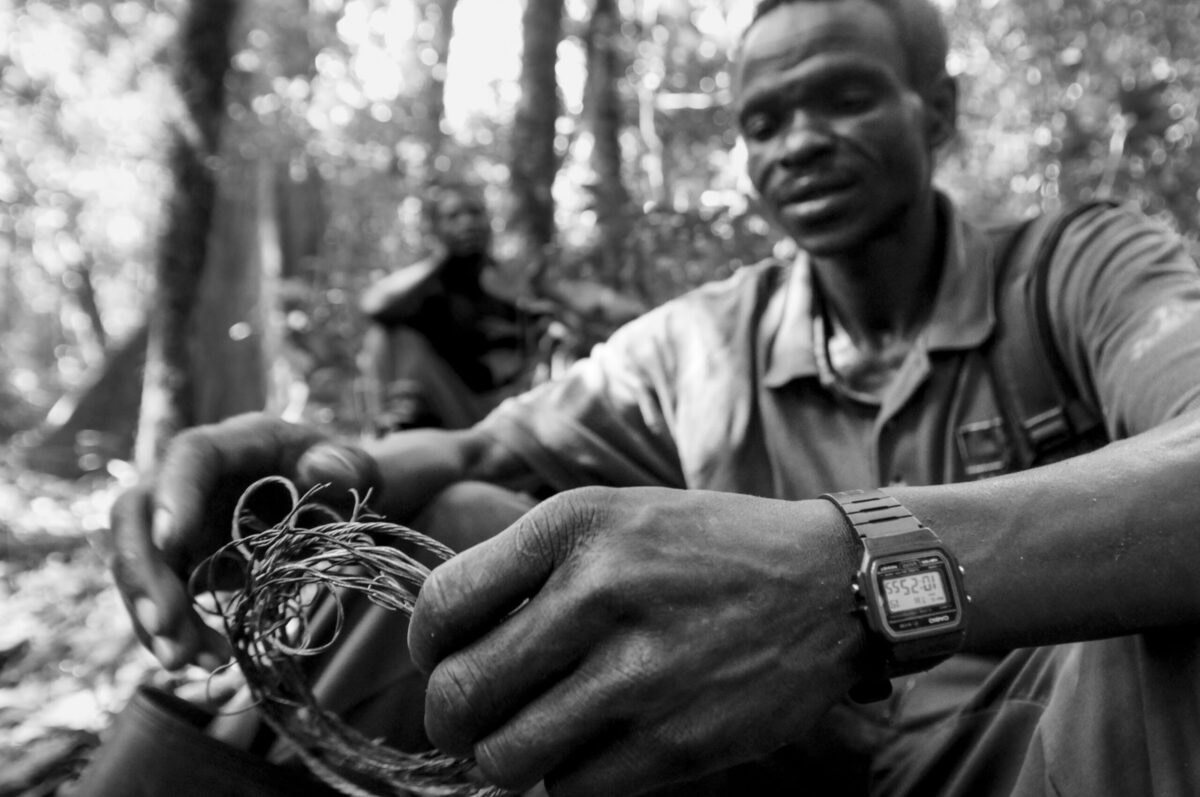It’s 10:25am, and Ofen and the Eco Guards take a short break. Budongo Forest, Western Region, Uganda, 2009.
Jo-Anne McArthur / We Animals
In honour of Dr. Jane Goodall, and the animals and people she dedicated her life to protecting.
In January 2000, the Jane Goodall Institute, in collaboration with the Budongo Forest Project, initiated the Budongo Snare Removal Project deep in the tropical rainforests of western Uganda. Far from any major town near the village of Sonso, former poachers would be employed to remove traps, used to catch “bush meat”, from the forest. The project headquarters were in the Budongo Conservation Field Station (BCFS), below the famous “Chimpanzee Tree”. But more on that tree later.
Budongo is home to a glorious variety of wild animals: chimpanzees, many species of monkeys, olive baboons, rodents like the Gambian pouched rat, and ungulates like duikers, bushbucks, and giant forest hogs. The carnivores were elusive so I didn’t see any, but leopards, civets, genets and mongooses were nearby but out of view.


Colobus monkeys along the wall of an abandoned building near the Budongo Conservation Field Station.
Snares, made of wires, cables, branches and sticks, trap indiscriminately. We’re accustomed to thinking of sea life when we hear the term “bycatch”, but bycatch occurs in forest hunting too, and can include chimpanzees and many other animals who aren’t eaten. Tragically, hunters set thousands of snares, only to catch a few animals. And since rainforests are so dense, many of these snares go undetected or unrecovered, resulting in an untold number of animals being maimed or dying in vain.

I spent a few long and rewarding days documenting the efforts of the snare removal team, also known as the forest’s Eco Guards. I followed them as they thrashed their way through dense brush with machetes, and it was fascinating to see through their keen eyes what I could not: finely laid, camouflaged traps near the ground. It was no wonder so many animals going about their way became trapped.
The Eco Guards heard an animal and lifted a hand to silence us, then slowly moved in their direction. We found a snared duiker, her abdomen squeezed by wire. She was still alive, but her hind end had been partially eaten by a scavenger. I could not imagine the depth of fear and suffering she had endured. The Guards quickly euthanized her. A duiker may be a new species to you. They are a tiny, shy African antelope known for their hunched posture and small, pointy horns. With solemnity, the Guards dug a hole in the ground and buried her.

A duiker was found badly ensnared and then euthanized by the Eco Guards.


Villagers sign a document (ink on thumb, to paper) saying that they will not lay snares in the forest.

A wild chimpanzee with a lame hand and visible scarring from a snare.

Lemi Moses removes a trap from the forest.

A wild chimpanzee near the Budongo Conservation Field Station.
This shoot was facilitated by the Jane Goodall Institute in Entebbe, which also served as my home base during my time in Uganda. I was incredibly sick with Dengue Fever, though, which I’d contracted in Cameroon. I was taking doses of steroids that would allow my hands, legs and feet to function. I could not use stairs, hold a camera or even a mug without them. And I did not want to stay in bed indefinitely and give up this story opportunity.
One morning, someone at the Institute told me I could get a ride to Budongo if I hurried and packed my bags. There was “some filmmaker” and his driver stopping in at the Institute, who would be fine with me bumming a ride north. This would save me so much time! I moved as quickly as I could (very slowly) and made it down to the bottom of the long driveway. We introduced ourselves. Nice to meet you, etc., and off we went. As we made our way, I asked my host if I might know some of the films he’d worked on. He said I might. They were a series called Blue Planet and Planet Earth. Yes, I did know those films. I was riding with none other than Alistair Fothergill, the famous nature documentary film producer. I was chuffed. This was cool. And he was staying at the BCFS, too, to get some preliminary footage of a tree above the camp known to be full of foraging chimpanzees. Some of that footage can be seen in Chimpanzee, a film that would fill people with awe for these wild apes. Apes whom have been rightly given more protection in their home forests since the inception of the Snare Removal Project.













I’m grateful to the Jane Goodall Institute, the Budongo Conservation Field Station, the snare removal team: Ofen Anzima, Dominic Andii, Gideon Atayo, and Moses Lemi, and to Alistair Fothergill for the drive and good conversation.


